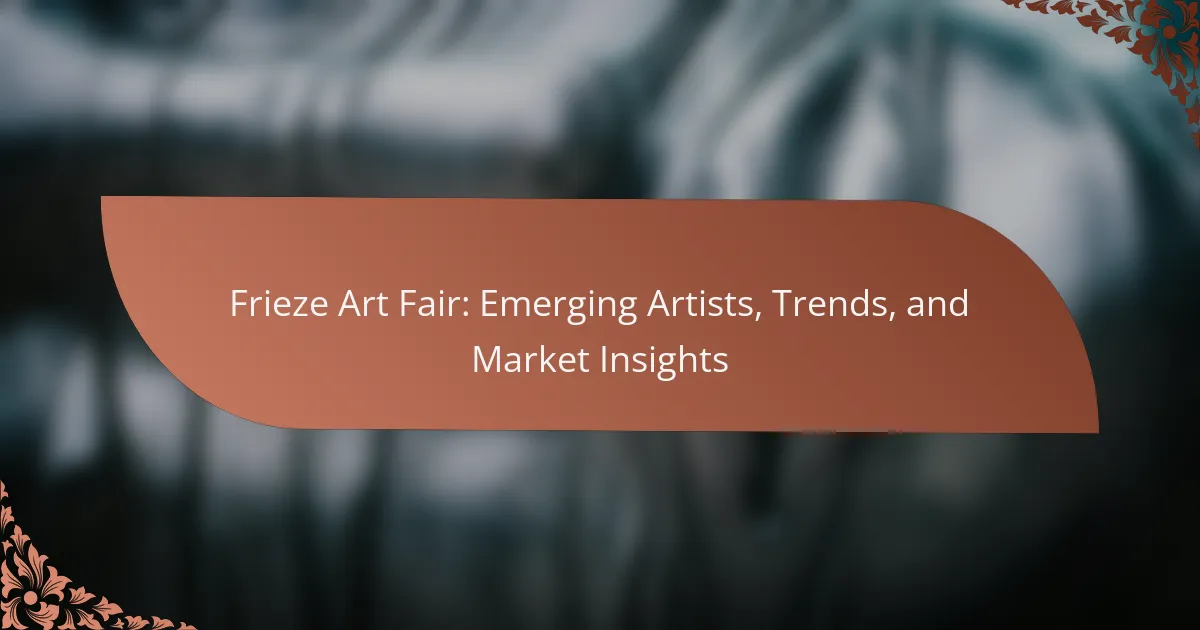The Frieze Art Fair showcases emerging artists while reflecting key trends in the art market. It emphasizes sustainability, digital art integration, and diverse representation. The fair provides visibility for new talent and offers valuable networking opportunities. Additionally, it reveals market insights on evolving investment strategies and regional variations in artistic focus.
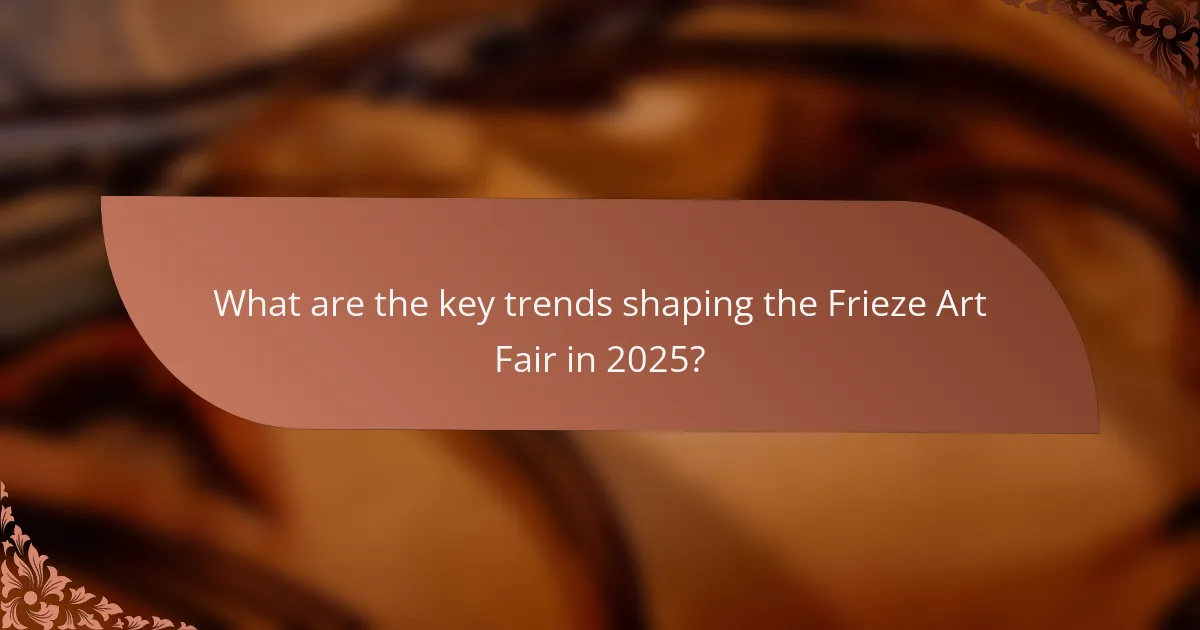
What are the key trends shaping the Frieze Art Fair in 2025?
Key trends shaping the Frieze Art Fair in 2025 include a focus on sustainability, digital art integration, and a rise in diverse representation. Sustainability is influencing artist practices and material choices, reflecting a growing awareness of environmental issues. Digital art continues to gain traction, with virtual exhibitions and NFTs expanding the market. Additionally, the fair is showcasing a broader range of artists from underrepresented backgrounds, enhancing inclusivity and cultural dialogue. These trends indicate a dynamic evolution in the art market, driven by societal changes and technological advancements.
How do emerging artists influence these trends?
Emerging artists significantly shape trends at the Frieze Art Fair by introducing innovative concepts and diverse perspectives. Their unique approaches challenge traditional norms, fostering a dynamic marketplace. For instance, the rise of digital art and sustainability themes reflects their influence. Emerging artists often attract younger audiences, shifting market focus towards contemporary practices. This evolution highlights the fair’s role as a platform for fresh talent, driving both artistic and commercial trends.
Which mediums are gaining popularity at the fair?
Digital art and immersive installations are gaining popularity at the Frieze Art Fair. Artists are increasingly leveraging technology to create engaging experiences. This trend reflects the market’s shift towards innovative mediums that challenge traditional art forms. Emerging artists are often at the forefront, utilizing virtual reality and augmented reality to captivate audiences.
What role does technology play in the evolving landscape of art?
Technology significantly shapes the art landscape by enhancing accessibility, enabling innovative creation methods, and transforming market dynamics. Digital platforms allow emerging artists to showcase their work globally, while tools like virtual reality and artificial intelligence push creative boundaries. Recent trends indicate a growing intersection between art and technology, with NFTs gaining traction at art fairs like Frieze, reflecting a shift in how art is perceived and valued. This evolution fosters a diverse marketplace that embraces both traditional and digital mediums, appealing to a broader audience.
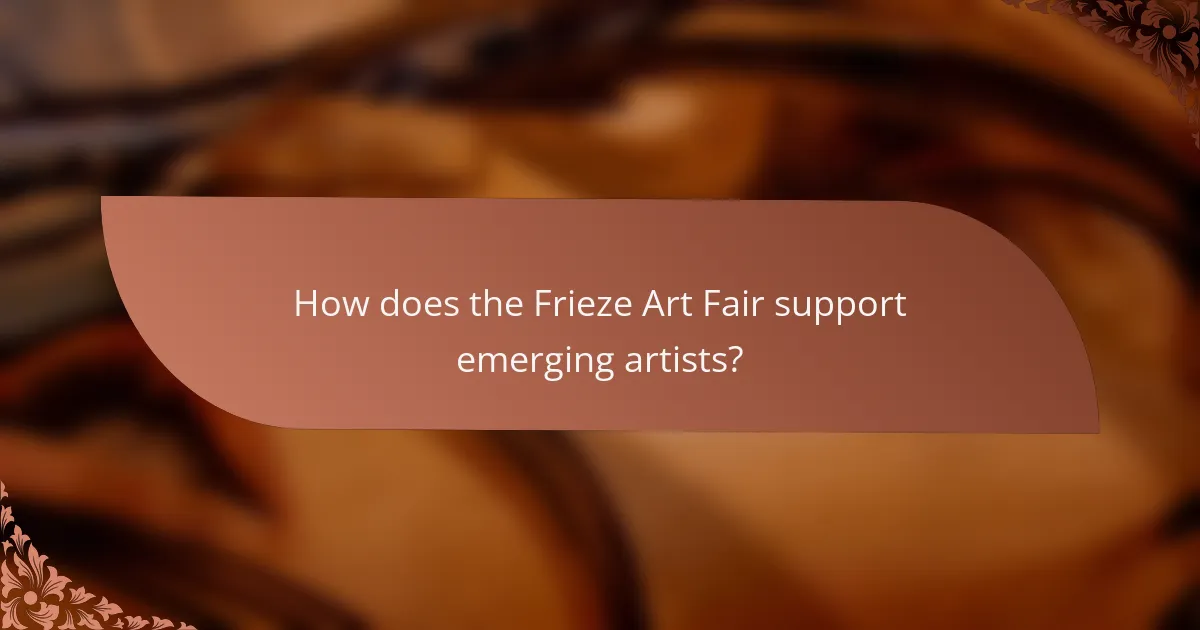
How does the Frieze Art Fair support emerging artists?
The Frieze Art Fair actively supports emerging artists by providing them with visibility and access to influential collectors. The fair features dedicated sections for new talent, such as the “Frieze New York” and “Frieze London” initiatives, which showcase innovative works. Additionally, the fair hosts panel discussions and networking events that connect artists with industry leaders. The exposure gained at Frieze can significantly enhance an artist’s career trajectory, leading to new opportunities and collaborations.
What opportunities are available for new talent?
The Frieze Art Fair offers numerous opportunities for new talent, including exposure to collectors, galleries, and art institutions. Emerging artists can showcase their work, gain visibility, and connect with industry professionals. The fair features curated sections dedicated to new artists, highlighting innovative trends and market insights. Additionally, participation can lead to potential sales and collaborations, enhancing an artist’s career trajectory.
How are galleries representing emerging artists at the fair?
Galleries are increasingly showcasing emerging artists at the Frieze Art Fair by prioritising innovative practices and diverse perspectives. Many galleries curate specific sections that highlight underrepresented voices, creating opportunities for these artists to gain visibility. Additionally, they often provide platforms for interactive installations and performances, which attract a broader audience. The focus on emerging talent reflects a shift in market trends, emphasising authenticity and originality over established names. This approach not only enriches the fair’s overall experience but also fosters a more inclusive art market.
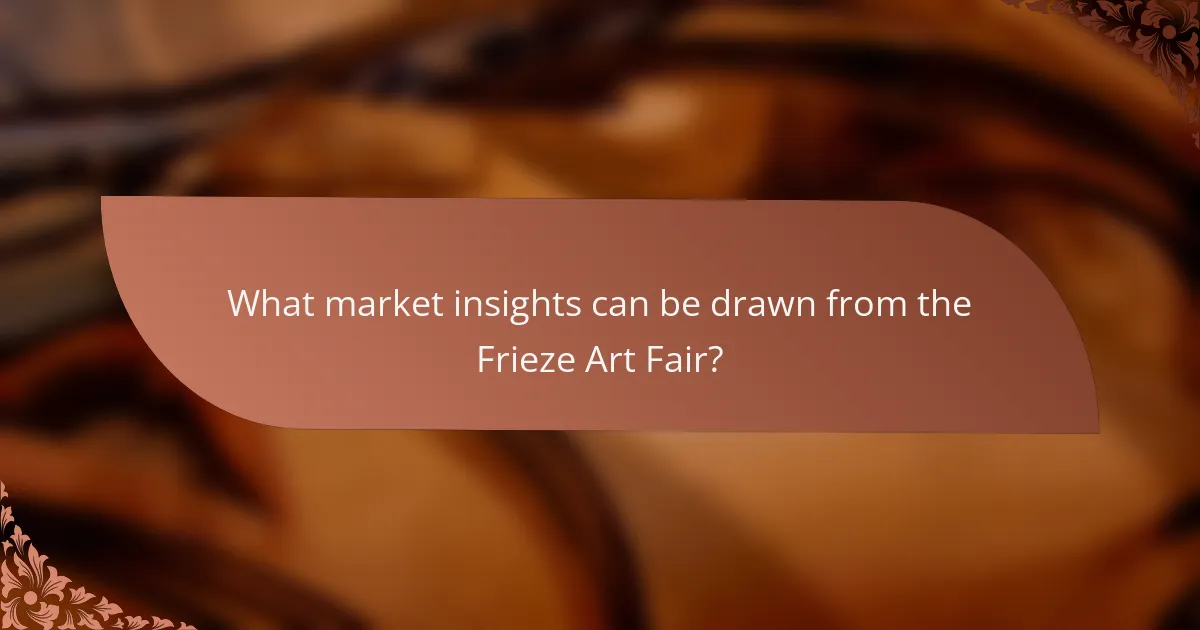
What market insights can be drawn from the Frieze Art Fair?
The Frieze Art Fair reveals significant market insights regarding emerging artists and current trends. Notably, the fair emphasises the rising prominence of diverse artistic voices, reflecting a broader cultural shift. Sales data indicates a growing interest in contemporary art, particularly from underrepresented demographics, showcasing a unique attribute of inclusivity. Additionally, the fair serves as a barometer for market trends, highlighting the increasing value of digital art and NFTs. As a result, collectors are shifting their focus, indicating a rare attribute of evolving investment strategies in the art market.
How do sales figures reflect current art market dynamics?
Sales figures reveal trends in artist popularity, pricing, and market demand at the Frieze Art Fair. Emerging artists often see increased visibility and sales, reflecting shifting collector interests. Insights into the art market dynamics show that innovative works attract higher bids, indicating a preference for originality. Additionally, data from recent fairs suggest that specific trends, such as sustainability and digital art, are gaining traction, influencing overall sales performance.
What demographic trends are evident among fair attendees?
Demographic trends among fair attendees show a diverse mix of age groups, with a notable increase in younger collectors. Approximately 40% of attendees are under 35, reflecting a shift towards millennials and Gen Z in the art market. Additionally, there is a growing representation of international visitors, with 30% coming from outside the host country, indicating a global interest in contemporary art. The gender balance is also shifting, with female attendees making up nearly 50% of the audience, highlighting inclusivity in art appreciation.
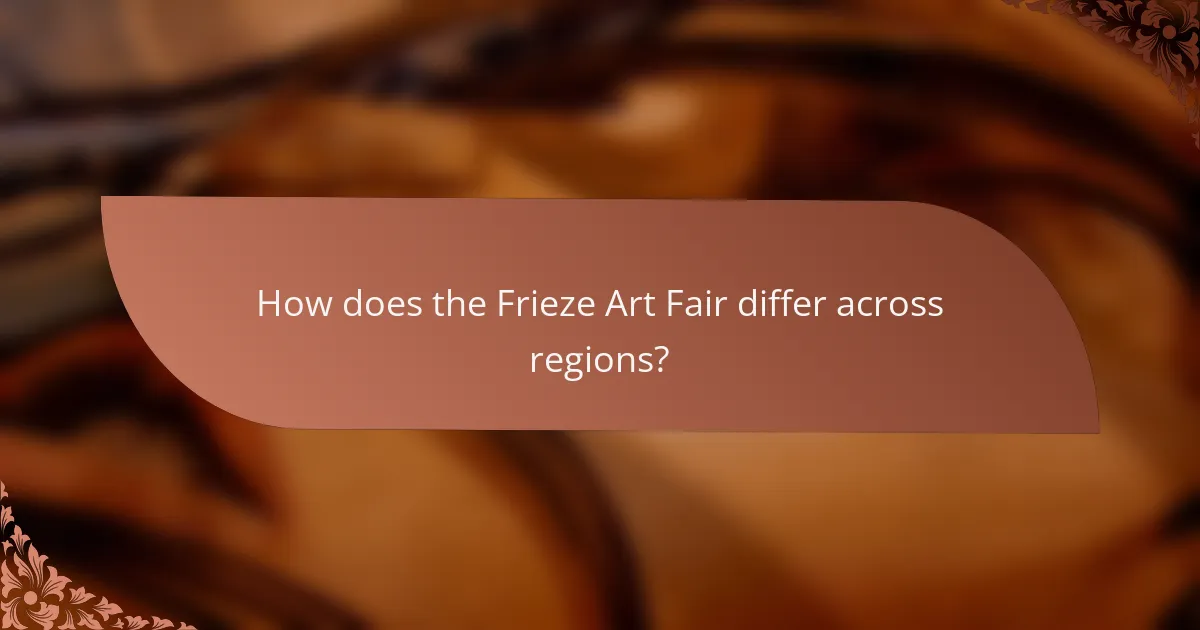
How does the Frieze Art Fair differ across regions?
The Frieze Art Fair varies across regions due to cultural influences, artist representation, and market dynamics. In London, it emphasises established artists and traditional galleries, showcasing a mix of modern and contemporary art. In New York, the focus shifts to emerging artists and innovative trends, reflecting the city’s diverse art scene. Los Angeles highlights performance art and multimedia installations, aligning with its experimental spirit. Each region’s unique attributes shape the fair’s overall experience and market insights, catering to local tastes and international collectors.
What unique attributes are present in North American exhibits?
North American exhibits at the Frieze Art Fair showcase unique attributes like innovative installation techniques, diverse cultural narratives, and a focus on sustainability. These elements highlight emerging artists and reflect current market trends. The exhibits often feature interactive art, engaging audiences in new ways. Additionally, they emphasise local community influences, creating a distinct regional identity within the global art scene.
How do European artists and galleries showcase their work differently?
European artists and galleries often showcase their work through innovative formats and platforms, differing significantly from traditional methods. The Frieze Art Fair highlights emerging artists and current trends, emphasising market insights that shape the art landscape.
Galleries frequently utilise digital platforms to reach broader audiences, while artists engage in collaborative projects that reflect contemporary issues. For instance, immersive installations and interactive experiences have become popular, attracting diverse visitors.
Additionally, the Frieze Art Fair serves as a significant marketplace, connecting artists with collectors and curators, which influences how art is perceived and valued. This dynamic environment fosters a sense of community among artists, galleries, and audiences, redefining the art experience in Europe.
The unique attribute of the Frieze Art Fair is its ability to spotlight emerging talent alongside established names, creating a rich tapestry of artistic expression that engages both local and international audiences.
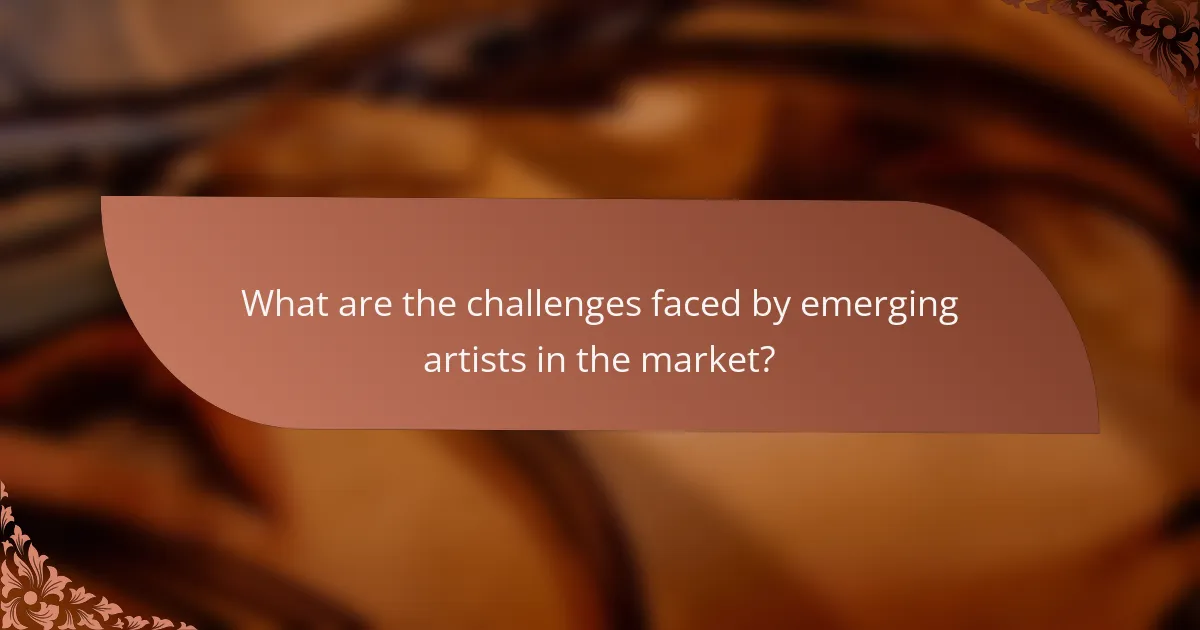
What are the challenges faced by emerging artists in the market?
Emerging artists face numerous challenges in the market, including limited visibility, financial instability, and competition. They struggle to gain recognition in a saturated market, often lacking access to established networks. Financial barriers hinder their ability to produce and promote their work effectively. Additionally, market trends can be unpredictable, making it difficult for them to align their art with buyer expectations.
How can artists navigate the complexities of art pricing?
Artists can navigate art pricing complexities by understanding market trends, establishing their unique value, and leveraging fair platforms. Researching comparable sales at events like the Frieze Art Fair helps set informed price points. Engaging with collectors and curators provides insights into demand and perceived value. Additionally, artists should consider their career stage and the rarity of their work, as these factors significantly influence pricing strategies.
What common pitfalls should emerging artists avoid?
Emerging artists should avoid common pitfalls such as neglecting marketing, underpricing their work, and lacking a clear artistic identity. These mistakes can hinder visibility and growth in the competitive art market.
First, failing to establish a strong online presence limits opportunities for exposure. Artists must leverage social media and personal websites to showcase their work.
Second, underpricing can devalue an artist’s work and affect perceived quality. Researching market standards helps set appropriate price points.
Lastly, a vague artistic identity can confuse potential buyers. Artists should cultivate a unique style and narrative that resonates with their audience.
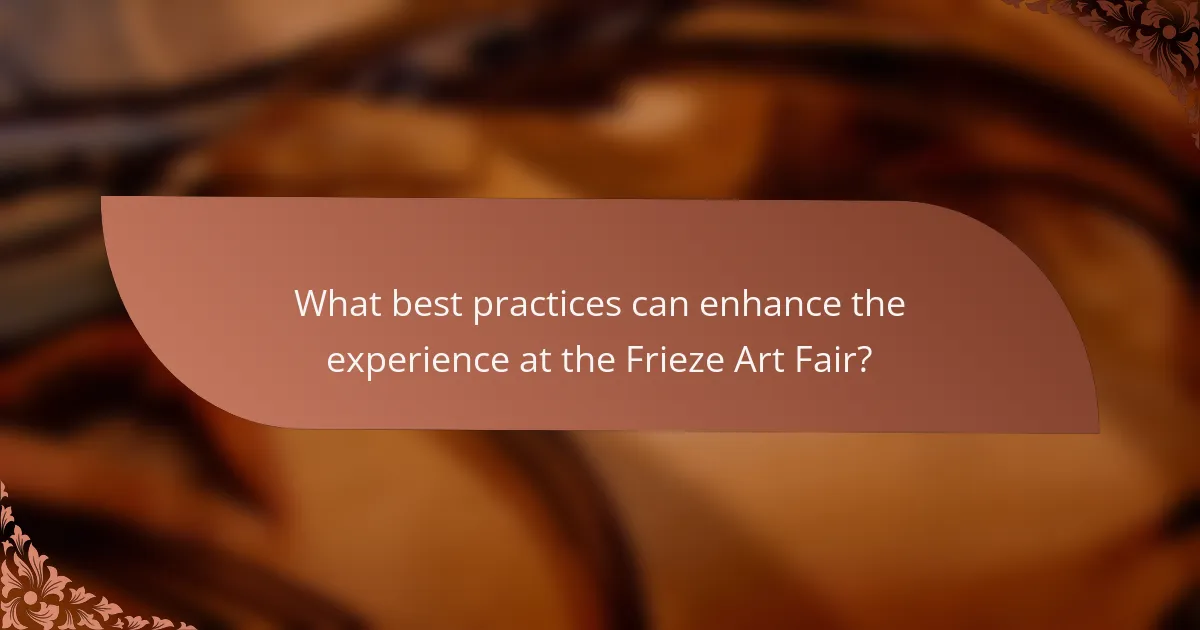
What best practices can enhance the experience at the Frieze Art Fair?
To enhance the experience at the Frieze Art Fair, prioritise engaging with emerging artists and understanding current trends. Attend artist talks and panel discussions to gain insights into their creative processes and market dynamics. Explore curated exhibitions that highlight innovative practices, which can provide a deeper appreciation of contemporary art. Utilise digital platforms and social media to connect with artists and fellow attendees, fostering a sense of community.
How can attendees maximize their time at the fair?
Attendees can maximize their time at the Frieze Art Fair by planning ahead and focusing on key areas of interest. Prioritise emerging artists and current trends to gain market insights. Arrive early to navigate the fair efficiently and engage with exhibitors. Take advantage of guided tours and panel discussions for deeper understanding. Network with artists and collectors to enhance your experience. Utilise the fair’s app for real-time updates and schedules.
What strategies should artists employ to network effectively?
Artists should engage in strategic networking to maximize opportunities at the Frieze Art Fair. Building authentic relationships with galleries, curators, and fellow artists is essential.
Participating in panel discussions or artist talks can enhance visibility. Social media platforms, particularly Instagram, offer avenues for showcasing work and connecting with art enthusiasts.
Collaborating with established artists can also provide valuable exposure and mentorship. Attending previews and exclusive events allows artists to meet influential figures in the art market.
Lastly, following up with contacts after the event is crucial for maintaining relationships and exploring future opportunities.
